|
Author: Dmitry Evseev, Simferopol
Technique of the first solo-ascents in the Crimea. How it was
 Dmitry Evseev
|
The article was built on recollections of Jury Lishaev. (Fantik)
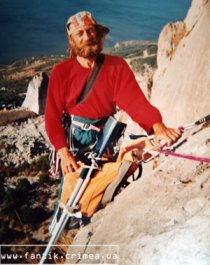
Morcheka
|
The period when most part of the routes in the Crimea was passed is years 1980-1996. That time there was lack of equipment, alpinism and rock-climbing were wide-spread, rescue services were furious and solo-ascents were prohibited by the figures of trade union alpinism.
Solo ascents are the ascents when the alpinist passes the route single-headed. He himself organizes the belay, and often goes without it. If he feels that can pass the strip on the verge of falling down. There are only mountain, man and weather.
What makes people do their solo-ascents? At first, it is terrible hunger for climbing. Every alpinist works for passing more difficult route than he has ever passed, to develop his skills and rise in his own self-consciousness.
When you are doing solo-ascents, you don&rsquot depend on your partner, his schedule of work, choice of the route and level of climbing. For making solo-ascents, passing hard routes, indomitable character, great experience of ascents, high level of rock-climbing and luck are necessary. Solo ascent is the highest level of alpinistic mastery.
Nowadays great experience of making ascents has been accumulated, special equipment has appeared. And earlier alpinists had to invent, produce and test everything on their own.
- Jury, what did the equipment you used look like?
I used nuts, cam devices, rocky hooks, hatchets, when I made winter ascents, I used short ice-screws. I produced them without assistance. And sometimes I used bolts. Generally speaking, all the equipment: ropes, carabineers, climbing shoes I swapped for titanic hooks, but that took place later. And the first triangular carabineers climbers from Krasnoyarsk gave me: I climbed &ldquoSamolet&rdquo up to the end without any belay on a bet. It was one of my first serious solo ascents. As for ropes &ndash at first I used simple fishing halyard, that didn&rsquot stretched at all. When I had been to America, they told me that I learnt climbing well because of our equipment. Falling was simply dangerous for life.
- And where did you climb in America?
In Smit-Rock, I went to Manhut. In general, I climbed well there, I passed on-sight three routes of 5.14 grade of difficulty. Americans suggested me to stay in USA, but I didn&rsquot want to.
- How did you organize belay during your solo ascents?
The first two routes were routes of the fourth grade of difficulty on Sokol and on Angarka. I fastened rope downwards, tied &ldquograsping knot&rdquo and climbed up. But then I quickly understood that it was not effective. And instead of &ldquograsping knot&rdquo I began to use the knot &ldquostirrup&rdquo.
- Tell us more details about it, please.
I fastened the end of the rope usually at the bolt downwards. Then I tried on the distance up to the next point of belay, chose the necessary metric area of the rope, tied it to the carabineer by the knot &ldquostirrup&rdquo, carabineer fastened to the harness, and started climbing. I didn&rsquot use quickdraws, only carabineers. When I put a nut, I tied &ldquostirrup&rdquo there too. In that case it appeared under load and didn&rsquot fly away from the rock. But in 1981 I was nearly killed by that system of belay. I climbed solo the right rhomb on the Foros Cant. There somewhere hooks had already been hammered. On the upper part of the route I fastened self-belay to that hook, took the rope up to the next point of belay, tied &ldquostirrup&rdquo. And the hook jumped out. I flew down for 40 meters, pulled out all the belays, cut off several bolts and hung on a nut that was a sling with a knot on the end. I injured liver, pain was terrible, but I completed the ascent. And then I spent 40 days in a hospital. After that event I began to use two &ldquostirrups&rdquo and two carabineers. Because if the hook jumped out earlier, I would die. That time I had import rope, I swapped it for twenty titanic hooks.
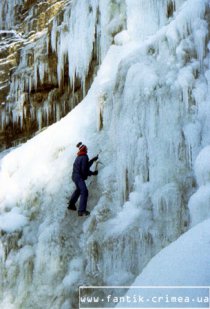
Ascent to the water-fall Uchan-Su.
|
- Jury, did you do many winter ascents?
Yes, I did winter ascents in the Caucasus, in Middle Asia, and in the Crimea. In the Crimea, apropos, there is rather serious climbing along wandering ice on Angarka, Ai-Petri. I also climbed to Uchan-Su. The waterfall is located on the Southern side, so ice there is not reliable. The main waterfall doesn&rsquot freeze together with basis. It is 90 meters high and every moment all this mass of the ice can be crushed. I waited for the opportunity when the base would freeze for three weeks. During the ascent after every hammer blow water streams got out from the cracks. When I reached the top I was absolutely wet. I climbed to Uchan-Su for 3 times, two of then without any belay. Frozen waterfall is very beautiful it looks like the great veil of fiancйe, that sparkles in the sun.
- And what are the most difficult routes in the Crimea you passed as a pioneer?

Miroslav Shmidt Jury Lishaev
|
They are Brov (&ldquoEyebrow&rdquo) and Stolb (&ldquoPost&rdquo) on the Morcheka. Brow is a very beautiful route. As Miroslav Shmidt said, it looks like El-Capitan in miniature. Miroslav Shmidt was well-known Czech alpinist, who died during his solo-ascent to the El-Capitan. I passed more then 40 routes in the Crimea as a pioneer. My routes were often entered in alpinistic competitions as someone&rsquos own and they won the first places. Sometimes it was so that several teams entered one my route passed for the first time. Solo ascents were prohibited in the USSR. But I didn&rsquot feel hurt of it. I climbed and felt thrilled of it. Most of emotions I spent when I passed without belay the route Truba (&ldquoPipe&rdquo) on Morcheka. I climbed for thee hours, the most difficult strip I passed very quickly and then I seemed tense played its role and I simply couldn&rsquot climb for 40 minutes. I rested. All of my ascents I tried to make without using self-made points of rest. I used the technique of trad-climbing only if I had no another possibility. I think that people that use self-made points of rest simply can&rsquot climb well. I distressed with the amount of bolts and holes for sky-hooks on the routes that I repeated after the trauma. The routes were damaged, it seemed that those alpinists had nervous attack. I climbed in Czechia a lot, there are some routes where is prohibited to use magnesium and different ferrata. And the distance between the hooks sometimes is about 20 meters. I passed of such a routes, it is called Glazka, of 70 meters long. I was going to pass in a team with to Czechs, but they refused from climbing up to the top. When I prepared for passing kilometer-long walls like Egnob, Kirpich, Eri-Dag, I organized marathons for myself. Usually I made it on Morcheka. I climbed 3-4 routes one after another and passed the night on the wall. It could take place in ten meters above the earth and in the middle of the wall, too. One of the routes that stuck to memory became the route Rhomb in the region of Uzunkol. It was a classical 600-meters long route and then it went to the right. And I decided to continue it straightly, along the overhangs and I continued it for 300 more meters. I chose that route because a year before my good friend had been lost there. He had been alpinist from Lvov, Sergey Mesnik, I made ascents in the Crimea with him. I passed that route in 1991. In the middle of the route I fall 10 meters down, injured the palm and had to climb using almost only one hand. The ascent was delayed and I had to pass the night on the wall. The weather was bad: it was raining and snowing. I got into crack. That night I passed sitting. All the night long I was waiting for sun-rise. I reached the top at midday. And on the descent I say glacier lake higher the pass and bathed in it. I couldn&rsquot refuse myself to take such a pleasure. But I also can boldly say that all of my achievements before the trauma were trifling matter, not more, than a stroll along the sea-front in Yalta. Comparing to the climbing when I have become an invalid. When there is no sensitiveness in legs many technical methods are inaccessible. I have pain in vertebral column after the fracture. But all these grow dark in front of the desire to pass the route and struggle against my own weakness. Nowadays it doesn&rsquot matter for, whether I make the ascent to Morcheka or descend to Bezdonka on Chatir-Dag.
- Jury, and have you ever tried to take part in expeditions, organized by alpinistic clubs?
When I began doing solo ascents, I understood I had nothing common with gregarious alpinism it is my own term for Soviet alpinism. When you work in a team, you feel yourself as a detail of a big machine that, strangely enough, works like military mechanism. Everything is done in a system, and according to someone&rsquos order, that often is not the best one. And there was no alpinistic clubs that could take me, all of them were frightened. Solo ascents were prohibited in the Soviet Unit and you could easily become disqualified, lost all your titles. I often got conflicts with the administrations of the alpinistic centers. Sometimes I even scuffled with them, I had to prove my right for choice such way. The doings of the administrations of the centers were not legal.
www.fantik.crimea.ua
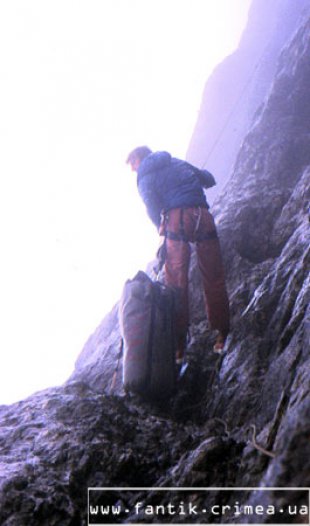
Ascent to Kirpich
|
|
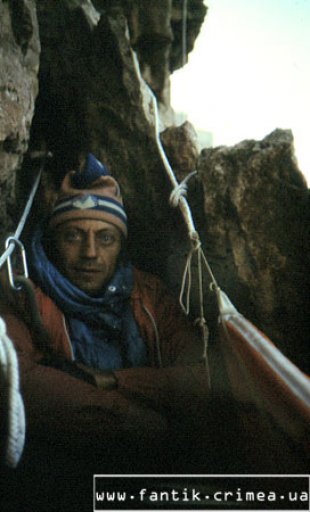
Passing night on the wall
|
|
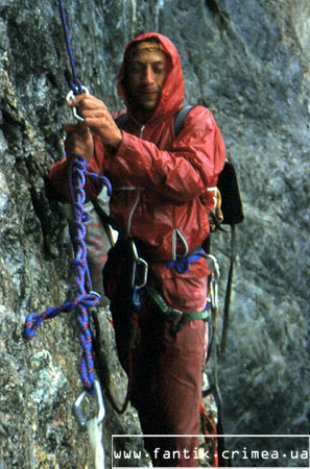
Ascent to Egnob |
|
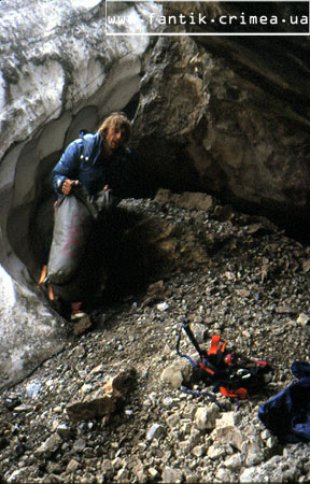
Preparation for the climb
.
|
|
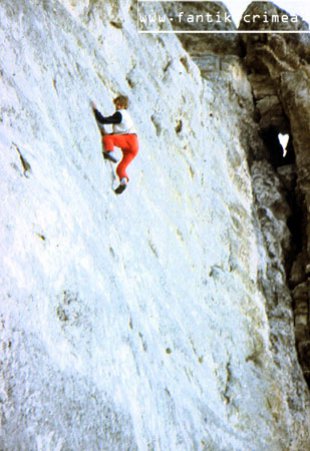
Solo on the Petrovsky rocks
|
|
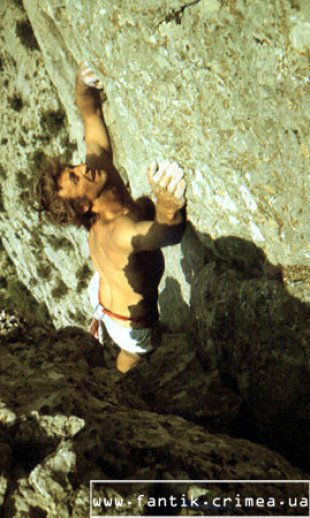
Solo on the Rhomb
|
|

Czech Republic
|
|
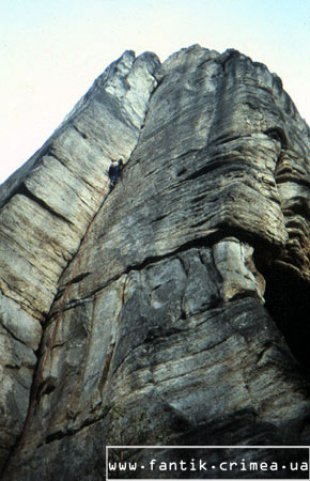
Czech Republic
|
|
|



 При вводе Логина и Пароля,
При вводе Логина и Пароля,




 При вводе Логина и Пароля,
При вводе Логина и Пароля,

